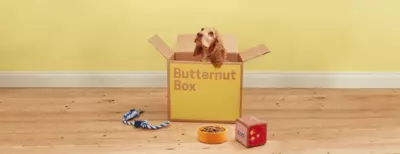How Often Should You Feed a Puppy?
- 06 Apr 2021
- 6m read

One of the most important things to do when you bring your puppy home is to establish a good routine. Routines help your puppy to feel less anxious about the world around them and gives them something that they can rely on. One of the easiest ways to get into a good routine is to start with set meal times and patterns.
How Many Meals Should a Puppy Have?
Most puppies are fully weaned from mother’s milk sometime between 6 and 8 weeks old.
After this, most pet parents will start by feeding their puppy 4 or 5 times a day whilst they are still under 3 months old. This can be dropped to 3 times a day until they are 6 months old and then eventually, you can settle on twice a day once your puppy is older than 6 months.
This is because younger puppies have smaller stomachs and also burn energy very quickly with all the playing they do, so small but frequent meals often work best. Regardless of how many meals you're feeding your pup, feeding at the same time every day will help to establish a routine. It won't be long before your pup can start telling the time.
Ultimately it's completely up to you how many meals you feed your puppy, it's all about what works best for you both. As long as they’re getting their required volume of food per day, divided up between mealtimes, you’re good to go.
You should ensure that you provide plenty of time after meals for your pup to digest their food and poop it out shortly after. This is usually within 30 to 60 minutes.
Where Should I Feed My Puppy?
Another important consideration is where to feed your little pup. You'll want to find a calm and quiet space that feels safe, so best to avoid any busy parts of the house like by the fridge or anywhere too noisy, such as next to the washing machine. You might find it helpful to try out a few different areas before settling on the best space where your puppy is happiest to eat.
Your pup is likely to be fairly attached to you in the early stages, so we would recommend feeding them somewhere that they can see you. The kitchen is usually a good place to feed your pup, especially if you have a hard floor that’s easy to clean.
How to Feed a Puppy
Now that we've figured out how often to feed your puppy and where to feed them, let's talk about how to feed them.
It's good to serve your puppy's food in a variety of different bowls to get them used to different materials and shapes to avoid any future aversions to shapes or materials they're not used to. Try out stainless steel bowls, ceramic bowls, shallow bowls, wide bowls, slow feeder bowls with bumps and grooves in; you can even ditch the bowl altogether and try out a lick mat.
If your puppy doesn't finish their full portion, be sure to throw away any food after it's been left down for 30 minutes or so. This will help your pup to understand that they have to eat during these mealtimes and discourage them from becoming picky and choosy later on.
Remember to have a bowl of fresh water on offer at all times and give their bowl or mat a good wash, ready for the next portion.
What Human Food Can Puppies Eat?
We wouldn't recommend feeding your puppy any human food.
It's crucial to keep puppies on a complete diet of dog food that is going to provide all of the nutrients that they need. That being said, a snack of safe fruit or vegetables, in small bite-sized amounts isn't going to hurt.
As you get to know your puppy more, you might notice that they're very keen on anything and everything related to food! If this is the case, it's important to get into good habits around human food as soon as possible to avoid those big, pleading puppy-dog eyes, lots of drooling and begging behaviour every time you eat your dinner.
As well as being good mannered, this will also reduce the risk of your puppy eating something that might harm them, like chocolate and raisins, or becoming overweight due to all the table-scraps they've eaten.
To encourage good habits around human food, you can start by ensuring your pup is away from the dinner table or wherever you're eating your meal. You can settle them down in their bed or crate in a different room and offer them a food puzzle, or something to chew on and keep them busy whilst you're eating your food. You can even feed them their meals at the same time as you eat yours.
As you spend time training your puppy, basic commands such as 'sit', 'stay', and 'leave it' will come in very handy to make sure your dog stays put in their bed, even if the smell of your spaghetti bolognese is luring them.
Rewarding Good Behaviour
It's really important to reward your puppy for their good behaviour at mealtimes. If they’ve eaten all of their dinner, make sure that they know they’ve done a good job. Positive reinforcement is a must at this stage, so that they’re encouraged to eat food that will help them to grow big and strong.
Similarly, if they've stayed in their bed for the entirety of your meal, be sure to give them lots of fuss and praise after so they'll know to do the same thing next time.
Bon(e) appétit!
Butternut Box Food is Perfect for Puppies
Here at Butternut Box, our meals are human-quality, hypoallergenic and perfectly portioned. What does this all mean? Well, we only use the best ingredients in our food. That includes quality meat and fresh vegetables, as well as protein-packed quinoa and fibre-rich lentils. We even add herbs to our meals for an extra boost of nutrients and flavour. You won’t find any hidden nasties in there either, like additives and preservatives found in lots of other dog food.
All of this put together makes our food hypoallergenic, meaning that it won’t trigger any symptoms of intolerance in your pooch, such as itchy skin and diarrhoea.
With 12 meal options to choose from, it would be really hard for your pup to get bored. Variety is the spice of life after all. From chicken to beef, veggie to plant based and everything in between, there’s a favourite for everyone.
One of the most difficult things with raising a puppy is knowing exactly how much to feed them to make sure that they are growing at the correct rate.
We make this really easy for you. By telling us some info about your puppy- such as their breed, age, weight and activity level, we will be able to work out exactly how much they need each day. We then send your meals out in perfectly-portioned pouches. Simply defrost in the fridge, serve up and let our delicious meals work their magic.

.jpeg)
.webp)

